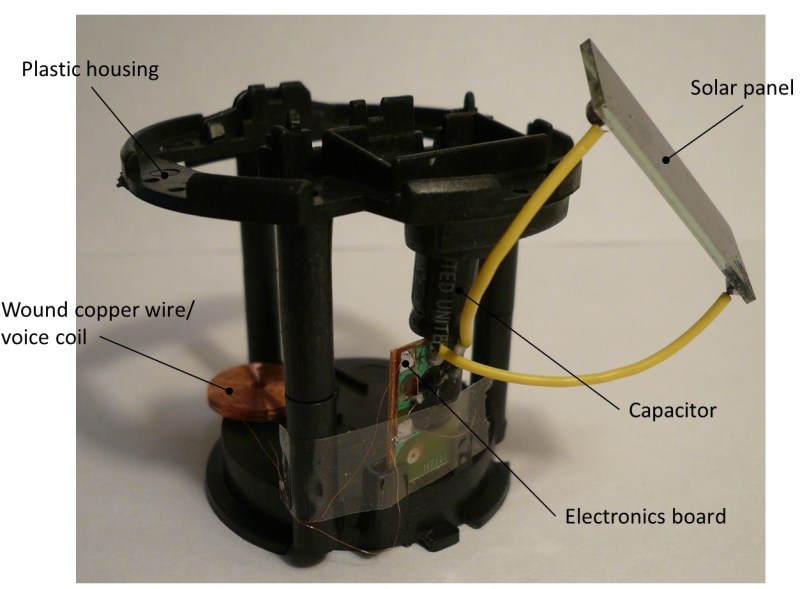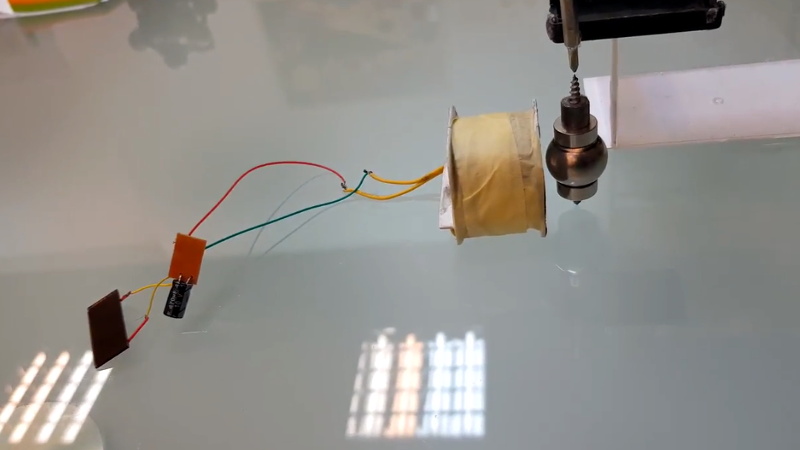At this point we’re sure you are aware, but around these parts we don’t deduct points for projects which we can’t immediately see a practical application for. We don’t make it our business to say what is and isn’t worth your time as an individual hacker. If you got a kick out of it, great. Learned something? Even better. If you did both of those things and took the time to document it, well that’s precisely the business we’re in.
 So when [Science Toolbar] sent in this project which documents the construction of an exceptionally energy efficient spinning neodymium sphere, we knew it was our kind of thing. In the documentation it’s referred to as a motor, though it doesn’t appear to have the torque to do any useful work. But still, if it can spin continuously off of the power provided by a calculator-style photovoltaic cell, it’s still a neat trick.
So when [Science Toolbar] sent in this project which documents the construction of an exceptionally energy efficient spinning neodymium sphere, we knew it was our kind of thing. In the documentation it’s referred to as a motor, though it doesn’t appear to have the torque to do any useful work. But still, if it can spin continuously off of the power provided by a calculator-style photovoltaic cell, it’s still a neat trick.
But how does it work? It starts by cracking open one of those little solar powered toys; the ones that wave or dance around as soon as any light hits the panel in their base. As [Science Toolbar] explains, inside these seemingly magical little gadgets is a capacitor and the classic black epoxy blob that contains an oscillator circuit. A charge is built up in the capacitor and dumped into a coil at roughly 1 Hz, which provides just enough of a push to get the mechanism going.
In the video after the break, [Science Toolbar] demonstrates how you can take those internals and pair it with a much larger coil. Rather than prompting a little sunflower or hula girl to do its thing, the coil in this version provides the motive force for getting the neodymium sphere spinning. To help things along, they’re even using a junk box zero friction magnetic bearing made up of a wood screw and a magnetized screwdriver tip.
It’s an interesting example of how a tiny charge can be built up over time, and with a nice enough enclosure this will make for a pretty cool desk toy. We’ve previously seen teardowns of similar toys, which revealed a surprising amount of complexity inside that little epoxy blob. No word on whether or not the version [Science Toolbar] cannibalized was quite so clever, however.
















In the mid-80’s I worked at the calibration lab at a Texas Instruments semiconductor manufacturing facility. One of the highly accurate instruments we had was a Leybold Heraeus spinning ball viscometer. This measured air (vacuum) pressure by suspending a metal ball in a magnetic field, spinning to a carefully measured RPM, then allowing it to coast. The rate at which the ball’s spin slowed was proportional to the gas pressure surrounding the ball. This “toy” could serve the same function. And, since it’s magnetically suspended, it would also work in a sealed container of liquid.
Calibration might be particularly difficult, but I like the idea… Measuring vacuum these days is pretty easy with an off the shelf micron gauge meant for HVAC. It might be useful for gauging mixtures of gasses as I would imagine each has a different coefficient of friction, eg helium/argon mixes for welding.
Hook it up to a well-made crystal power cell in parallel, and it could probably spin for *decades*.
Okay, there ain’t even a proper wikipedia entry for this. Just UFO blogs and free energy crank sites. Is this real? demonstrably real? Or does the fact that I need proof mean that the lizards have already got to me?
This thing will already spin for decades if put on a windowsill.
First sentence on Keith’s blog… quotes Deepak Chopra. Woowoowoowoo! The siren’s gone off!
You’ve got a windowsill that sits in sunlight all day?
Not to worry. Everything I own spins at 1 rev/day.
It’s not a lot of power; and it isn’t coming from magical overunity or something; but that’s the mechanism behind the passive AM crystal radios. Just enough energy to drive a set of headphones not terribly loudly, if you are close enough to the transmitter.
Probably enough power for this application.
From what I’ve seen in my search to find out what they are all about, they seem to use a piezoelectric effect. Some of the tear-down images show that the large crystals form with enough force to split the copper pipe that the cells are made with. I’m not interested enough to really investigate it myself, but I’m thinking that a design with anode & cathode sheets in a spiral could maximize the surface area.
A what now?
Just Google it. They are pretty cool and not hard to build.
Does it create motion from a power source? It’s a motor.
Is it a useful motor? That’s a different question.
Whether a motor is useful is a function of what kind of downgearing (or other form of mechanical/electrical advantage) you can afford and how long you’re willing to wait.
If it catches the attention of a child and promotes some technical thinking, it’s a useful motor.
I can genuinely see this inside one of those wooden office toys. It wouldn’t be hard to nicely mount the solar panel in a discrete way to make it appear to work by magic…
Hello guys !
Sorry for the late reply.
Some applications for it :
1. It can be an interesting office toy here is the final stage for this purpose : https://youtu.be/SmomuCGypko
2. It can be transformed into a small office DC or Ac generator :) – educational purpose
3. waiting for other sugestions
TESTS :
It this test is working also with a 30 mm neodymium sphere 110g weight + the weight of screw and metal cases, with the same setups :
https://youtu.be/Wq0vrXmSpsg
2. Transforming it into an DC generator : https://youtu.be/BhZ4kNVp20w
I asumed that in this movie is function as mechanical inverter ( high voltage, low amperage ), I was able to measure only the voltage, the motor stops when I set the multimetter on current, due to the internal resistance of the multimetter. :)
PS : Free energy does not exists. No machine can create energy out of nothing, as this would violate the law of mass-energy conservation, which is fundamental and universal. You tube is full of movies with content coresponding to free energy devices which should be deleted if you ask me because some people will invest time and money to replicate them and the kids and not only them will get a wrong ideea.
3. Transforming it into an AC generator : https://youtu.be/K1VM4yc3PKA
Thx
S.T.
How did the idea come to me?
First time I made a ROTATING MAGNETIC FIELD GENERATOR 383 HZ, which I proposed for researh (an open project ) on https://publiclab.org/wiki/applications-of-rotating-magnetic-fields-biotechnology-rotating-magnetic-fields-rmf-generator-x-device, more specific ” Rotating magnetic field generator against viruses,bacteria, malaria, tumor, autoimmune encephalomyelitis, chronic obstructive pulmonary disease”
The electric motor presented is some how related with the RMF generator, a derivative product.
THX
S.T